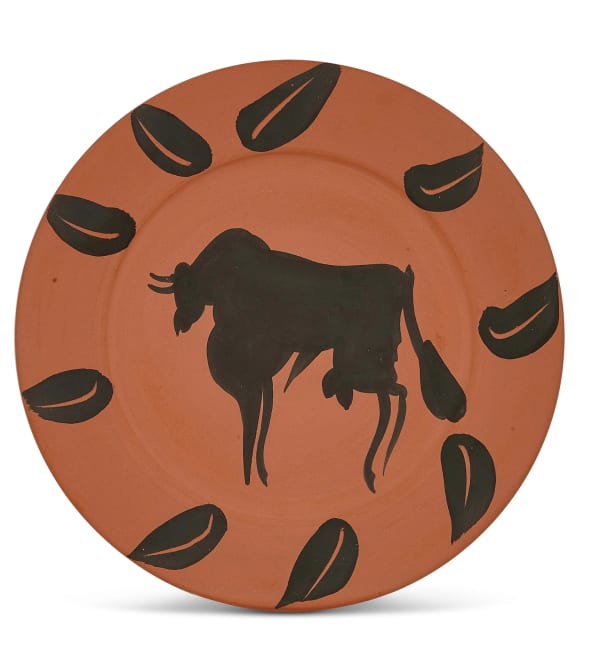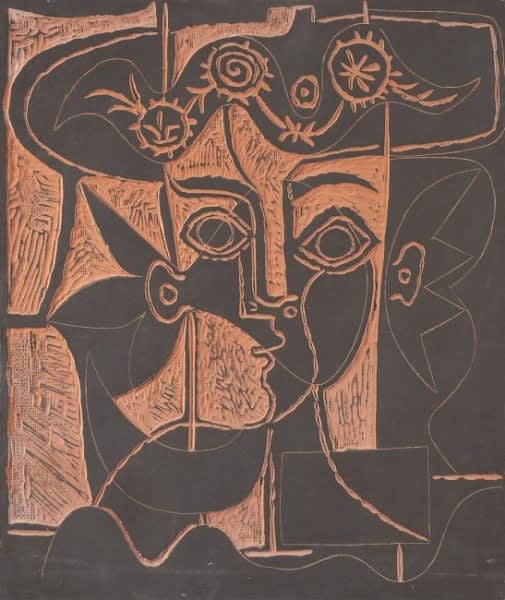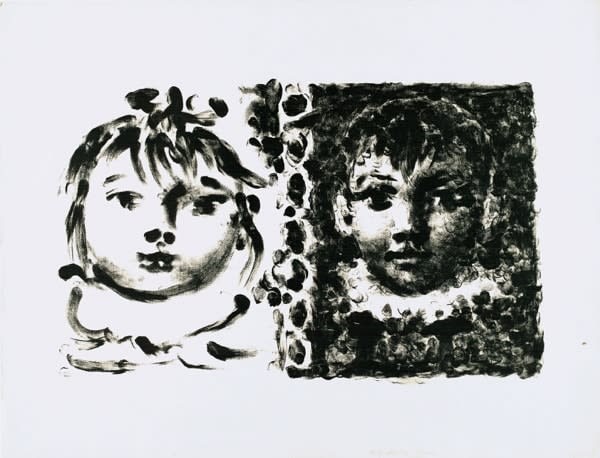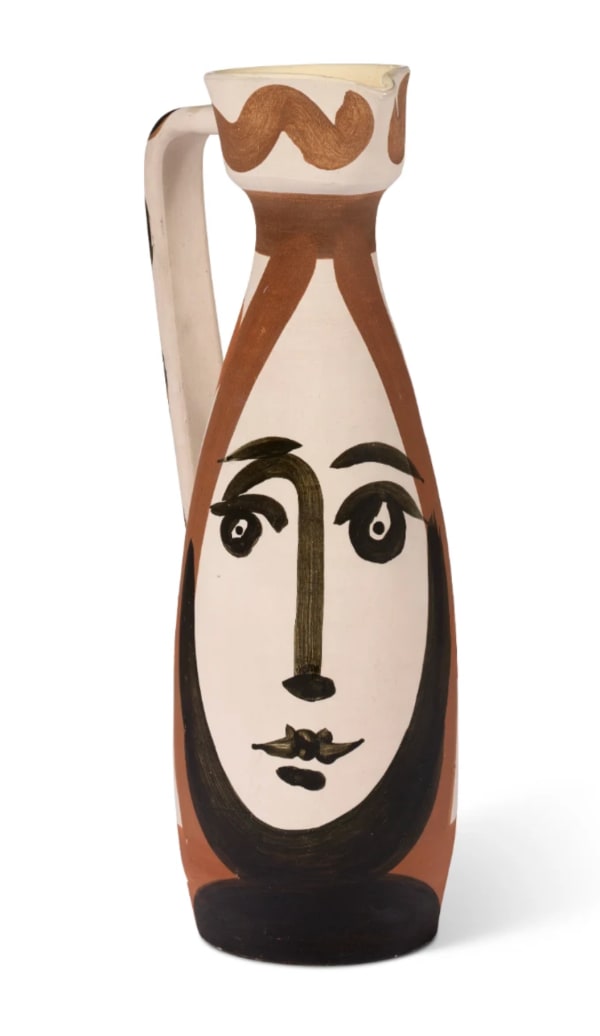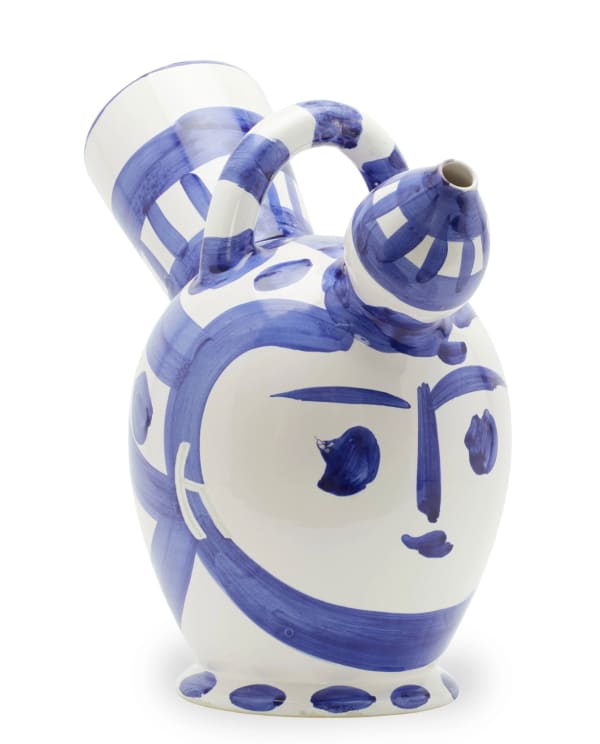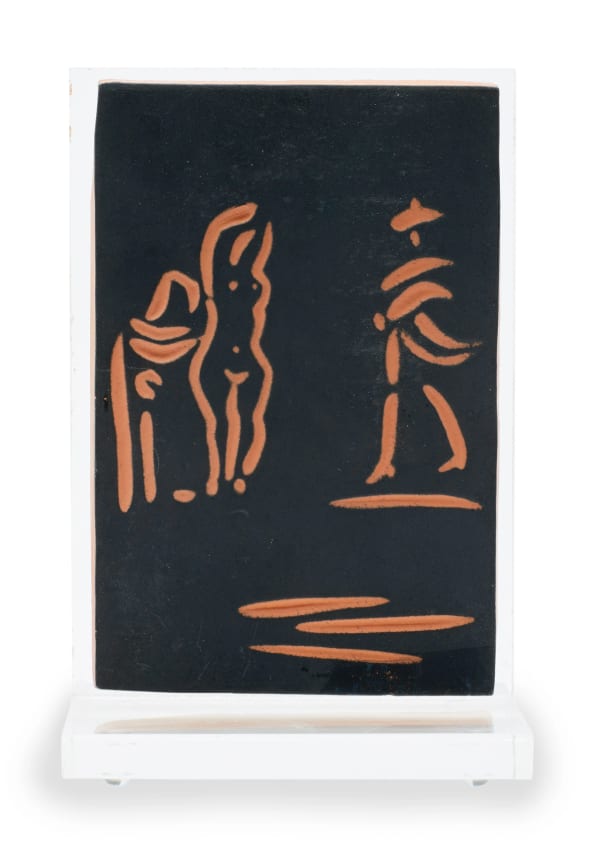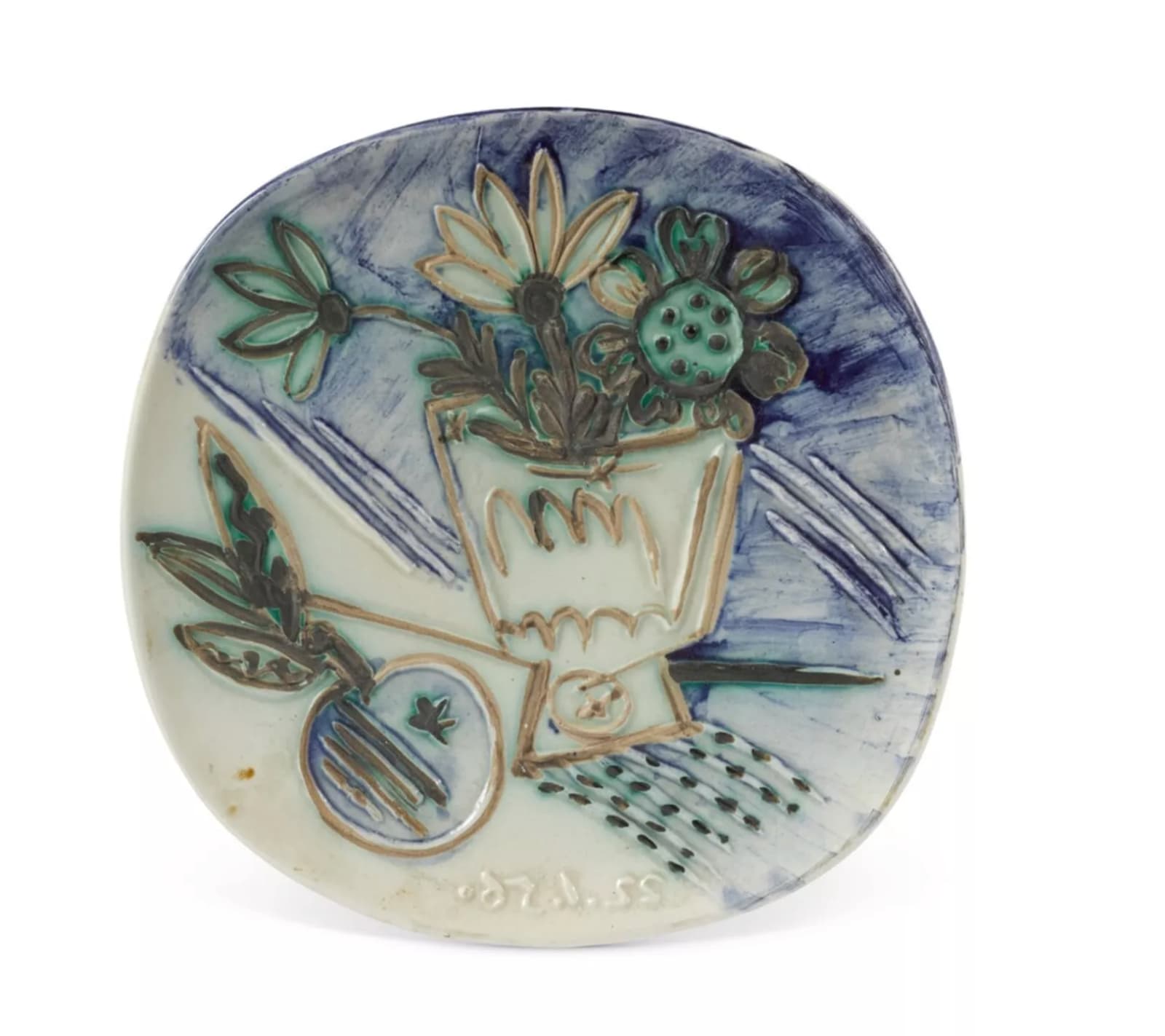
Pablo Picasso
25.4 cm
This 1956 ceramic plate by Pablo Picasso, Bouquet à la pomme, is an elegant example of his extraordinary mastery of ceramics, a medium he embraced with prolific creativity during his later years in Vallauris. Executed in white earthenware clay with decoration accentuated by oxidized paraffin and oxides under glaze, the work combines the painterly vitality of his graphic art with the tactile richness of clay, demonstrating how Picasso seamlessly translated his vision across multiple disciplines.
In Bouquet à la pomme, Picasso uses the possibilities of earthenware to blend painting, relief, and engraving in a single object. The flowers in a pot and the accompanying apple are outlined with incised lines that carve into the clay surface, while washes of blue, green, and earthy tones provide color and depth. The oxidized paraffin technique, which resists glaze in certain areas, accentuates the drawing-like quality of the decoration, allowing Picasso to treat the ceramic surface much like paper or canvas.
The use of oxides under glaze gives the plate a luminous, painterly quality, as the blues and greens merge fluidly into the creamy white ground. The result is an artwork that is both utilitarian and sculptural, blurring the line between fine art and decorative object.
The composition presents a vase of flowers at the center, radiating outward in bold yet simplified forms. A single apple lies beside it, its rounded body counterbalancing the upright verticality of the bouquet. The incised lines and textured diagonals in the background infuse the surface with energy, preventing stillness and reinforcing a sense of rhythm.
The flowers are not depicted with naturalistic detail but rather with the playful stylization characteristic of Picasso’s hand. Their petals and leaves become almost emblematic, capturing the essence of vitality rather than botanical accuracy. This simplification links the plate to Picasso’s broader artistic language, where reduction of form heightens expressive power.
Picasso’s engagement with ceramics began in 1946, when he visited the Madoura pottery workshop in Vallauris, France. What began as curiosity quickly grew into a passion that would result in over 4,000 ceramic works over the next 25 years. Far from treating ceramics as a secondary pursuit, Picasso reinvented the medium. He developed unique techniques such as using paraffin resist, playing with slips and glazes, and incorporating sculptural reliefs and embossing.
In works like Bouquet à la pomme, his mastery is evident in how he integrated line drawing, color washes, and texture into a unified decorative scheme. Unlike traditional pottery, which often emphasized repeated motifs, Picasso’s ceramics were highly individualized, each infused with the same inventiveness he brought to painting, drawing, and printmaking.
The bouquet motif is a recurring theme in Picasso’s oeuvre, often symbolizing life, renewal, and celebration. Transposed into ceramic form, it becomes both timeless and intimate, bringing the vitality of the natural world into a domestic object. The apple, a symbol resonant with themes of fertility and abundance, adds another layer of meaning, grounding the floral vitality in earthy sensuality.
This plate also reflects Picasso’s larger philosophy: that art should not be confined to canvases or galleries but should live in daily life. His ceramics often blurred the distinction between art and utility, turning plates, pitchers, and bowls into sculptural canvases.
Bouquet à la pomme embodies Picasso’s mastery of ceramics and his prolific creativity in the medium. With incised lines, painterly washes, and a lively sense of composition, he transformed a simple earthenware plate into a vibrant work of modern art. This piece underscores his ability to adapt his language of form, line, and color to any material, reaffirming his position not only as one of the greatest painters and printmakers of the 20th century but also as one of its most innovative and prolific ceramicists.
-
 Pablo PicassoVisage, 1963
Pablo PicassoVisage, 1963 -
 Pablo PicassoVisage gravé , 1948
Pablo PicassoVisage gravé , 1948 -
 Pablo PicassoDanseurs, 1956
Pablo PicassoDanseurs, 1956 -
 Pablo PicassoService visage noir, 1948
Pablo PicassoService visage noir, 1948 -
 Pablo PicassoProfil de Jacqueline, 1956
Pablo PicassoProfil de Jacqueline, 1956 -
 Pablo PicassoTaureau, marli aux feuilles, 1957
Pablo PicassoTaureau, marli aux feuilles, 1957 -
 Pablo PicassoTaureau sous l'arbre, 1952
Pablo PicassoTaureau sous l'arbre, 1952 -
 Pablo PicassoVisage, 1965
Pablo PicassoVisage, 1965 -
 Pablo PicassoToros, 1952
Pablo PicassoToros, 1952 -
 Pablo PicassoVisage no. 197, 1963
Pablo PicassoVisage no. 197, 1963 -
 Pablo PicassoVisage géométrique, 1956
Pablo PicassoVisage géométrique, 1956 -
 Pablo PicassoGrande Tête De Femme Au Chapeau Orné, 1964
Pablo PicassoGrande Tête De Femme Au Chapeau Orné, 1964 -
 Pablo PicassoGrand Tête de Femme au Chapeau Orné (Ramié 518), 1964
Pablo PicassoGrand Tête de Femme au Chapeau Orné (Ramié 518), 1964 -
 Pablo PicassoCentaure, 1956
Pablo PicassoCentaure, 1956 -
 Pablo PicassoGothic Pitcher with Leaves | Pichet gothique aux feuilles, 1952
Pablo PicassoGothic Pitcher with Leaves | Pichet gothique aux feuilles, 1952 -
 Pablo PicassoFemme échevelée, 1963
Pablo PicassoFemme échevelée, 1963 -
 Pablo PicassoDeux Oiseaux, 1963
Pablo PicassoDeux Oiseaux, 1963 -
 Pablo PicassoPicador, 1952
Pablo PicassoPicador, 1952 -
 Pablo PicassoPaysage, 1953
Pablo PicassoPaysage, 1953 -
 Pablo PicassoProfil de Jacqueline, 1956
Pablo PicassoProfil de Jacqueline, 1956 -
 Pablo PicassoPlongeurs, 1956
Pablo PicassoPlongeurs, 1956 -
 Pablo PicassoCorrida sur fond noir, 1953
Pablo PicassoCorrida sur fond noir, 1953 -
 Pablo PicassoPaloma et Claude, 1950
Pablo PicassoPaloma et Claude, 1950 -
 Pablo PicassoVisage, 1955
Pablo PicassoVisage, 1955 -
 Pablo PicassoPichet à glace, 1952
Pablo PicassoPichet à glace, 1952 -
 Pablo PicassoFemmes et toréador, 1968
Pablo PicassoFemmes et toréador, 1968 -
 Pablo PicassoFigure de proue, 1952
Pablo PicassoFigure de proue, 1952 -
 Pablo PicassoVisage au nez pincé, 1959
Pablo PicassoVisage au nez pincé, 1959
Join our mailing list
* denotes required fields
We will process the personal data you have supplied in accordance with our privacy policy (available on request). You can unsubscribe or change your preferences at any time by clicking the link in our emails.
This website uses cookies
This site uses cookies to help make it more useful to you. Find out more about cookies.





